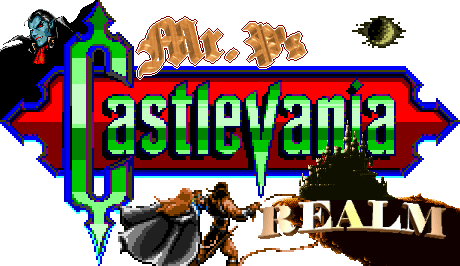
![]() Castlevania References
Castlevania References ![]()
![]()
|
Select Your Page
|
[Hai no Majutsushi] [Konami Wai Wai World] [Wai Wai World 2] [Kid Dracula] [Ganbare Goemon 2] [Gokujou Parodius] [Battle Tryst] [Konami Krazy Racers] [DMTV: World Fighters] [Konami WaiWai Sokoban] [Eternal Knights 2] [New International Track and Field] [THE-BishiBashi] [Hirameki Pazuru Makkusuueru no Fushigina Nohto] [Orecabattle] [Super Smash Bros. Ultimate]
[Castlevania References] [Borrowed Elements]
![]()
|
TMNT:
Turtles Tournament Fighters
|
 |
Date Released
|
Created
By
|
|
1993
|
Konami
|
|
|
Systems
For
|
Playable
Characters
|
|
|
SNES, Genesis
and NES
|
Multiple TMNT
Mascots
|
|
|
Reference
Made
|
||
|
If
you don't move the cursor on the title screen, one of three demo modes
will begin shortly after boot up. Thereafter, it will spotlight one
of the characters by showing him, her or it in action, this followed
by a profile that shows nicknames, heights, weights, eye colors, ages,
weapons, favorite activities and goals. It's the erratic Wingnut whose
profile makes reference to our series.
|
||
In the early 90's, fighting games, spurned by Street Fighter 2, were all the rage, for home consoles and especially in the arcades. Konami wanted to get in on the action, and they had a great license with which to work and apply--the Teenage Mutant Ninja Turtles, which had already peaked and would soon be ushered out by Power Rangers but was still an incredibly hot property. And Konami would show no shame and outright emulate Street Fighter 2's style of play with the Turtles characters plugged right in. Those characters include Leonardo, Donatello, Michaelangelo, Raphael, War, Aska, Wingnut, Armaggon, Chrome Dome, Cyber Shredder (this game's M. Bison) and secret characters Rat King and Karai.


Konami was given creative license to add to the characters' backgrounds, and they did so with our most notable specimen, Wingnut, whose profile lists its "Favorite Activities" as "Castlevania 2095." This is either a throwaway reference or foresight telling us how many sequels were to come. The mix seemed like a natural, but the game didn't fare too well critically or commercially despite fighting games' popularity or Tournament Fighters being available for the two most well-known 16-bit platforms; this may be why Konami maximized its available resources and even released a watered-down version of the game for the aging NES, which would again be following Capcom's lead in light of Mighty Final Fight. I used to play it a lot, actually, if only to abuse Cyber Shredder's aura-deflector shield.
|
Contra:
Hard Corps
|
 |
Date Released
|
Created
By
|
|
9/14/1994
|
Konami
|
|
|
System
For
|
Playable
Heroes
|
|
|
Sega Genesis
|
Ray, Sheena,
Fang & Browny
|
|
|
Reference
Made
|
||
|
Taking
an optional path on the game's third stage leads to a potential boss
encounter with an enemy who shares with the Belmont family of legend
a familiar fighting style, yet its appearance
could best be described as atypical of a Castlevania hero. While
the arena in which the battle occurs is standard Contra fare,
the music that rages in the background has Vampire Killer as
its intro.
|
||
Castlevania and Contra are two series whose fates seem intertwined, as if they together represent the juncture of Konami's golden age, when the gaming giant's franchises stood shoulder-to-shoulder with other big-name company's heavyweights. While gone are those days, the two have been known to rekindle a friendship--lately starring together in the compilation Konami Collector's Series: Castlevania and Contra on the PC and GameTap but having shared their first glance way back in 1994, when the much-overlooked Contra: Hard Corps came to the Sega Genesis.
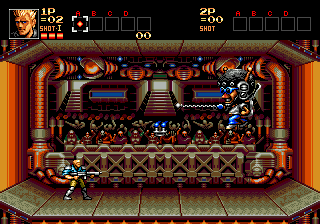

We find our Castlevania reference on the game's third stage, when nearing the exit the hero has a choice of clearing the stage or scaling a tall building, on top of which stands a well-dressed man whose association is unknown. The man makes the hero an offer: Accept his challenge (fighting a trio of bosses within the Arena) and earn some cash in victory. Should the hero accept, he'll immediately enter the cramped Arena and witness the entrance of his challenger--a bizarre combatant sporting a normal human frame but a huge alien-looking noggin. The unnamed foe, armed with a whip resembling the famed Vampire Killer, will start the festivities by striking the conveniently placed candelabra, which will drop its sub-weapon of choice--a big yellow fish which it can toss at short range.
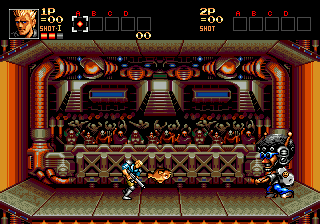
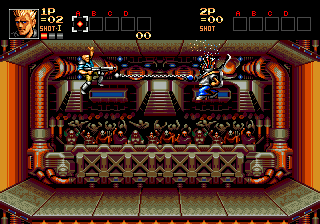
The alien hippie has a simple pattern: It runs back and forth within the narrow confines and stops only to execute in alteration its two attacks--a jumping whip-slash, which is somewhat effective, and a toss of its yellow fish, a methodical offensive maneuver during which it's highly susceptible to rapid fire. After it's been damaged heavily, its cranium will explode, leaving behind a headless but surprisingly resilient challenger whose assault will continue as originally planned. A few more shots will put it down for good, setting up the next, more difficult boss encounter. As noted, the battle music that plays in the background has as its intro the first line of Vampire Killer, the Castlevania series' most popular theme. This same song plays again during the credits earned by clearing this secret stage.
Click here to listen the aforementioned tune, game track number 15, as heard during the boss battle or sound test (music file contributed by Akumajou Otaku).
|
Snatcher
|
 |
Date Released
|
Created
By
|
|
11/30/94
|
Konami
|
|
|
Systems
For
|
Playable
Characters
|
|
|
Sega CD
|
Gillian Seed
|
|
|
Reference
Made
|
||
|
When
you're inside the Outer Heaven, you're given the option to survey the
show's audience. Doing so twice will unlock a sub-menu that allows
you to focus in on specific audience members. One of the selectable
names is "Castlevania pair," which refers to two familiar-looking
gentlemen seated in the lower-left corner. Upon seeing them, Gillian
and his navigation robot reminisce about their tortuous experiences
with the original Castlevania.
|
||
Even the most critically panned platforms were capable of producing some of the medium's most fondly remembered games. The Sega CD, for instances, gave us such classics as Sonic CD, Shining Force CD, Night Trap and what's said to be the definitive console port of Final Fight. And who could forget Snatcher--Hideo Kojima's cult-classic cyberpunk adventure game? This, the improved version of an earlier PC-8801 and MSX2 release, considered to be one of the man's best creations and has long since become synonymous with the Sega CD; its fans agree that it's one of those games that works to define it.
Snatcher is a text-based adventure game whose action is controlled via the use of menus. As is typical of this game type, you can interact with the world and its environments in a few different ways: You can observe and investigate a given scene. You can question onscreen characters by way of dialogue trees. And you can use obtained possessions to manipulate people and objects. That's how you go about completing the mission of Gillian Seed, an amnesiac who has joined the Snatcher-hunting agency JUNKER with the hope that his encounters with the feared human-mimicking robots will somehow help to restore his memory. Gillian--with the help of his navigation robot, Metal Gear (just so you know that this is a Kojima game)--must take to the streets and use his wits and his words to discover who's real and who's not and in doing so discover the truth about his history.
At one point, a masked Gillian arrives at a club called Outer Heaven (hey--did you hear that Hideo Kojima made this game?) with an appetite for buffalo. Once inside, he surveys the audience and notices that the whole lot of them are "dressed as characters from a classic late 20th-century video game," which suggests to he and Metal Gear that the club's owners must be nostalgic for that time-period. After looking the audience over a second time, he's given the option to focus on them individually. Among those he identifies are Sparkster from the Rocket Knight Adventures series; Goemon from the eponymously named Goemon series; Mr. Ueda from Lethal Enforcers; Bill Rizer and Lance Bean from the Contra series (on the menu, they're lumped together as a single entity simply called "Contra"); and Simon Belmont and Dracula from the Castlevania series (they, too, are lumped together as a single entity--the "Castlevania pair," as it were).
Obviously we're most interested in those last two gentlemen. Selecting the pair prompts a quick dialogue exchange between Gillian and Metal Gear. Gazing upon the pair, they reminisce about their experiences with the NES classic Castlevania, though their memories of such are a bit fuzzy if not completely suspect. In fact, Gillian remarks that he wasn't even alive at the time! Though, both of them are certain about the fact that the game's strict stair-climbing mechanics frustrated them to no end. So as we can see, Konami creators and characters alike knew the deal!
|
Metal
Gear Solid
|
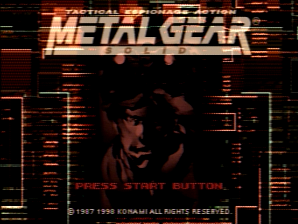 |
Date Released
|
Created
By
|
|
10/21/98
|
Konami
|
|
|
System
For
|
Playable
Heroes
|
|
|
PlayStation
|
Solid Snake
|
|
|
Reference
Made
|
||
|
When
you encounter Psycho Mantis in the Base Commander's room, he engages
in mind games by using his psychic ability to read your most-guarded
thoughts. This entails accessing data from your memory card. If you
happen to have a Castlevania: Symphony of the Night save file
on the card, he'll make note of such by knowlingly inquiring as to your
interest in the series.
|
||
The Castlevania and Metal Gear series occupy similar space in Konami's history: Both were born into this world in the mid-80s. Both produced inaugural entries that achieved standout status on the platforms that hosted them (the NES and MSX, respectively). Both found popularity enough to endure for decades. And both eventually found their way to PlayStation, which they supplied a pair of beloved heavy-hitters best remembered for how they reimagined their respective series' working formulas. One was Castlevania: Symphony of the Night, with which you're all likely already familiar, and the other was Metal Gear Solid--the classic stealth-based action game starring the legendary soldier Solid Snake. Konami's cinematic, story-heavy epic puts us in control of the gruff, gritty Solid Snake, who at the behest of Colonel Roy Campbell comes out of retirement to carry out a mission of great significance: He's to infiltrate the secluded Shadow Moses Island upon which stands a nuclear-weapons facility that has been taken over by the suddenly insurgent FOXHOUND--Snake's former unit; for the sake of the world, he's to locate and eliminate the group's leader, Liquid Snake, and destroy their Metal Gear weapon (codenamed "REX").
Along the way, Snake and his newfound ally Meryl Silverburgh (the colonel's daughter) arrive at the Base Commander's room, wherein they encounter the psychically gifted Psycho Mantis, a high-ranking FOXHOUND member. In the lead-up to battle, Mantis engages in mind games and effectively taps into Snake's most-guarded thoughts and memories. Most jarringly, this reading also entails his tapping into the player's "memory"--specifically the data found on his or her memory card. Of interest to Mantis is a given player's apparent fondness for other Konami properties as indicated by save-data for six specific games: International Superstar Soccer, Silent Hill, Suikoden, Azure Dreams, Poy Poy and, of course, Castlevania: Symphony of the Night. If such data exists for one or more of the aforementioned, Mantis will extract this information and smugly needle the player over his or her "secret" fandom. That's Metal Gear for you--always shattering that fourth wall!
|
Van
Helsing
|
Van Helsing is a popular figure in Dracula's history. The original Van Helsing, who appeared in old novels and monster movies, was an elder man, a vampire hunter with great knowledge of vampire lore; he used this expertise to help protect Lucy Westenra (or other such potential victims) from Count Dracula. The character has appeared in other related films and novels, including his genesis in Bram Stoker's Dracula, to fill a similar role as the resident know-it-all. His character's latest incarnation appears in the 2004 big-budget film Van Helsing, where it receives a bit of a facelift; in this form, Gabriel Van Helsing (played by Hugh Jackman) is a brooding vampire hunter, his qualities somewhere between Blade and Alucard, who uses his tools of destruction--mainly rifles and a discuss blade--to destroy vampires and other creatures of the night, like our pals Dracula, Igor, wolfmen and the obligatory harpies and banshees. Following an industry trend, a video game based on the movie was in the works during its production. (Click on a screenshot for the larger version.)
The game is loosely based on the movie's sequences, but it recreates well the film's atmosphere. It's a somewhat familiar atmosphere, too, for one reason: Due to its nature and its source material, Van Helsing is already closely related to Castlevania. Clearly, it shares the same universe of ideas (so much so that I'm surprised that the game wasn't licensed to and produced by Konami, which seems to know this material better than the game's creator, Vivendi Universal). However, Konami had to have some sort of influence on the project, because Vivendi Universal gives it a proverbial "shout out" in the opening of Mission 3, where our starting point is a library. (Click on the image for a larger version.)
 |
 |
It's in this library where Van Helsing can search a certain bookcase, as located on the room's left side, to find a tome that supposedly chronicles the history of old Transylvanian families. One book in particular catches the player's attention. As the game notes: "One well-worn book entitled 'The Belmonts' catches your eye." While it's merely a throwaway reference, it makes you wonder where the Belmonts were hiding while Dracula and friends were running wild. While an exact time-period can be identified (the year 1887, according to reader SaintofAthena), no true link can be made nor can any series overlap actually be proven. Oh, well.
|
Dance
Dance Revolution Ultramix 3
|
 |
Date Released
|
Created
By
|
|
11/15/2005
|
Konami
|
|
|
Systems
For
|
Playable
Hero
|
|
|
Xbox
|
You, the player
|
|
|
Reference
Made
|
||
|
A
song included in the package is titled Akumajou Dracula Melody.
While you act out the song using your dance pad, an animated person
will come forward from the background and start dancing within the castle
grounds, which resemble an area that looks as though it might come from
Castlevania 64. During the song, there is for
some reason a scream.
|
||
Dance Dance Revolution (known also as the acronym "DDR") is Konami's quirky music-game series that started life in Japanese arcades but through its rising popularity soon found its way to the world's most well-known consoles. There are, in fact, well over sixty iterations of DDR. To play a DDR game requires the use of a special dance pad (think "Power Pad") that's adorned with four directional arrows. To complete a song, the player must move in rhythm and dance in accordance to the arrows appearing concurrently onscreen. The iteration of DDR most important to us is Dance Dance Revolution Ultramix 3 for the original Xbox. (Click on the image for a larger version.)
 |
 |
With multiple versions and sequels spread over several systems, it's odd that it took Konami this long to make a series reference--but it happens here in the form of Akumajou Dracula Melody, a specially made tune whose quick tempo changes very much remind one of the difficulty experienced in a Castlevania title. It at first sounds like a wedding song (The Wedding March, in particular); it freezes during the 13th note due to a loud scream; it resumes with gothic rock that plays in the form of Cross Your Heart; it picks up after a low beat with a more natural Bloody Tears; and it then ends with the ever-famous "Game Over" jingle. (Thanks to SpikeyZ for this information.) Click the link to listen to Akumajou Dracula Medley (MP3).
 |
 |
|
Dance
Dance Revolution Universe
|
|
Date Released
|
Created
By
|
|
|
2/27/2007
|
Konami
|
|
|
Systems
For
|
Playable
Hero
|
|
|
Xbox 360
|
You, the player
|
|
|
Reference
Made
|
||
|
Though
in a lesser capacity, Castlevania is represented in Universe
much the same; it features the song Castlevania (Freestylin' Mix),
which is a remix of the classic Vampire Killer. The song is performed
on-screen to the game's usual trippy setting rather than decor taken
from the series.
|
||
Dance Dance Revolution Universe, the first of three-part sub-series available for the Xbox 360, is your typical DDR game: The player dances on his or her dancepad in rythm to arrows as they float up from the bottom of the screen. Universe is another of its kind to feature music inspired by the Castlevania series; its song collection includes Castlevania (Freestylin' Mix), A Jazz-style remix of the fan-favorite Vampire Killer theme as performed by WaveGroup feat. Nicky G.
 |
 |
Unfortunately, in contrast to the series' audio exploits experienced in other DDR titles, Freestylin' Mix does not come with its own background theme or special backdrop; rather, either a generic-looking male or female punker dances to the song as one of DDR's patented "whimsical, abstract" environments engulfs the action. Up to four players can compete to see which series fanatic can best execute the art of interpretive dance. Click the link to listen to Castlevania (Freestylin' Mix) (MP3).
|
DDR:
SuperNOVA 2
|
|
Date Released
|
Created
By
|
|
|
8/22/2007
| 9/25/2007
|
Konami
|
|
|
Systems
For
|
Playable
Hero
|
|
|
Arcade and
PS2
|
You, the player
|
|
|
Reference
Made
|
||
|
Konami
again calls upon its classic Castlevania music to help fill out
a Dance Dance Revolution soundtrack. It's this time SuperNOVA
2, which features an arranged version of Bloody Tears--one
of the more popular series tunes.
Of note is that players react to onscreen directions as layered over
a familiar (for PS2 owners) background animation sequence.
|
||
We don't measure Dance Dance Revolution by the pure amount of titles available but by its distinctively named sub-series. This version in particular is the second of the SuperNOVA sub-series, which has been available only in arcades and on the PS2. Despite the existence of new modes, Supernova 2's is classic DDR, with players dancing in rhythm to commands as they appear onscreen. They'll find this especially exciting as they rock out to Bloody Tears (IIDX edition), a Castlevania series standout.


What they'll find most surprising is that the sequence accompanying the gameplay is one familiar; the animated background is Curse of Darkness' opening movie, which will play uninterrupted as dancing fiends undoubtedly pay it little attention as they struggle to keep pace with the onscreen commands. While Bloody Tears has no actual relevance to Curse of Darkness' soundtrack, Hector, Isaac, Zead, St. Germain, Trevor Belmont and Julia Laforeze will appear, regardless, to perform a scene they've acted countless times before. Click the link to listen to the IIDX edition of Bloody Tears (MP3).
|
Pop'n
Music 15 Adventure
|
 |
Date Released
|
Created
By
|
|
4/25/2007
|
Konami
|
|
|
Systems
For
|
Playable
Hero
|
|
|
Arcade
|
You, the player
|
|
|
Reference
Made
|
||
|
Pop'n
Music 15 is another of Konami's music games to feature a tune from
the Castlevania universe. It's in this case Akumajou Dracula
Medley, a rather famous arrangement. As the tune plays, an animated
Simon Belmont can be seen marching along to the beat.
|
||
 |
Konami's game-and-music studio, called "Bemani," is responsible for all of the company's rhythm- and music-based games (including, of course, all such titles represented on this page). Another in its line of music series is Pop'n Music, which has multiple entries spread across arcades, consoles and portables. The earlier sequels were simply numbered until the arrival of the twelfth edition, when Konami began adding subtitles. This particular entry is Pop'n Music 15 ADVENTURE. Like just about all popular music games, Pop'n Music features notes scrolling down a number of slots (in this case nine) and requires that the player hit a corresponding button when the note passes through the symbol bar placed at the screen's bottom. The player must stay alive by keeping the song going, matching as many notes as possible, or risking failure via draining of a life bar that depletes any time a note is missed. In addition to normal play, there are multiple modes available, including those like "Challenge Mode," where you "battle" another character. Included in its collection, of course, is Castlevania music. As an arranged version of Akumajou Dracula Medley plays, a large Simon Belmont animation can be seen marching along to the song, whip in hand, while reacting to player actions. |
 |
Click the link to listen to its rendition of Akumajou Dracula Medley (MP3).
|
GuitarFreaks
& DrumMania V6
|
In this era of music-based games like Guitar Hero and Rock Band, it's not really a surprise to see Konami, the creator of longrunning music-game series predating this craze, throw its hat into the ring with Dance Dance Revolution and now its GuaitarFreaks and DrumMania franchises. Both are in line with standard music games, with notes scrolling down a slot and past a symbol bar whose icons correspond to buttons/shells the player must push/strike to record the note. The difference is that one uses a guitar peripheral while the other uses plastic drums. With the exception of a PS2 home adaptation, both are predominantly arcade series. And rather than sequels, they get "new versions," the latest of which is Version 6.


Making it easier to follow is the that Konami eventually combined the two series starting ay Version V, with the arcade machines for the respective games placed side by side, able to link together for competition supporting up to three players. In either version, you can play alone or compete against one or two friends to see who can better master the rhythm and pacing of Vampire Killer, ripped directly from Castlevania Judgment for the Wii. While the music plays, an action-heavy movie is shown to the slots' right side, adding context to the jamming session and lending the experience a Castlevania flare. Click the link to listen to its rendition of Vampire Killer (MP3).
|
Pop'n
Music 18 Sengoku Retsuden
|
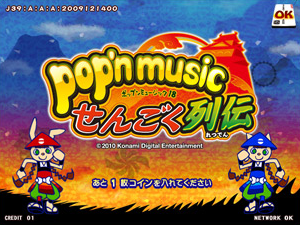 |
Date Released
|
Created
By
|
|
1/20/2010
|
Konami
|
|
|
Systems
For
|
Playable
Hero
|
|
|
Arcade
|
You, the player
|
|
|
Reference
Made
|
||
|
The
latest in Konami's near-annual Pop'n Music series is Pop'n
Music 18 Sengoku Retsuden. The largely familiar rhythm game is yet
another featuring Castlevania-themed music. It's in this case
Trezier de Spirit, as ripped straight from Pachi-Slot: Akumajou
Dracula. Hero Ralph (Trevor) Belmont can be seen marching along
to the music.
|
||
|
Pop'n Music 18 Sengoku Retsuden is another in the long line of Konami's Pop'n Music games, which seem to appear at a yearly pace. Now married exclusively to arcades, the social rhythm-game series continues to be a celebration of Konami's vast and ever-expanding archive of high-quality video-game music. Pop'n Music 18 continues the trend but this time with a theme: "Sengoku Retsuden," which is roughly translated to "the legend of warring states." This chosen time-period is reflected in the art direction, which dresses the game's array of cutesy characters in clothing and garb reminiscent of those worn in feudal Japan. The game's mechanics are otherwise familiar: As notes scroll down nine separate slots, the player required to hit a corresponding button whenever a note passes through the symbol bar placed at the screen's bottom. The goal is the continuation of a song to its end, precipitated by matching as many notes as possible and hopefully averting failure, suffered when your life bar is drained via repeated misses. Accompanying you in your mission is one of Konami's colorful characters, who march to the music and react accordingly to the player's actions. Joining the cast is Ralph "Don't Call Me Trevor" Belmont, who traipses along to his own personalized tune: Trezier de Spirit, which could also be heard in Pachi-Slot: Akumajou Dracula. Ralph will furiously flail the Vampire Killer whip or crouch in pain depending upon how accurate or not you are. |
|
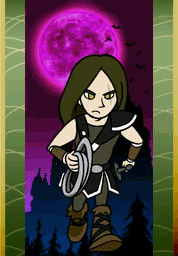 |
|
 |
 |
|
Click here to listen
to the Castlevania theme
|
|
Rock
of Ages
|
|
Date Released
|
Created
By
|
|
|
8/31/2011
|
ACE Team
|
|
|
Systems
For
|
Playable
Hero
|
|
|
Xbox 360,
PS3 & PC
|
You, the player
|
|
|
Reference
Made
|
||
|
The
game's rocky path rolls through Wallachia, home to a familiar-looking
castle. We also see what appears to be the personage of a Belmont hero
making his way into the castle, which is domain to Vlad Tepes--the stage's
boss.
|
||
Rock of Ages is best described as the Archaic Period version of ball-rolling games like Marble Madness and Monkey Ball. Your "ball," in this case, is avatar to Sisyphus, the ancient Ephyran king who for his crimes was punished by Zeus, forced to eternally roll a giant boulder boulder up a sharply sloped hill whose peak was home to only a drop. The Rock of Ages version of this cursed being has his own trial: He must maneuver his boulder through several stages to breach rival-castle defenses, mowing down all persons/structures that unfortunately litter the narrow pathways, then protect this newly conquered land from usurping mineral matter.
 |
 |
The stony rampage leads the player to an interesting stop: Wallachia, the region of Romanian known to series fans as home to Castlevania's Belmont family. Rock of Ages wastes no time making immediate reference. We quickly pan down to find a familiar castle whose gate is about to give entrance to an armored, whip-wielding chap; the figure jogs his way over to the surrounding moat, where he's unceremoniously crushed by the castle's drawbridge. Who should wander out from the haunted abode but impaler Vlad Tepes, who bears his fangs, transforms into a bat, and takes jittery flight. Though, the comical scene servers only as window-dressing--outside of squishing a flustered, largely immobile Vlad, the proceeding level makes no further reference to Castlevania or its universe.
 |
 |
Rock of Ages is a download-only title available for Xbox Live, the PlayStation Network, and Steam. It was published by Atlus Co., which has in the past collaborated with Konami on certain projects. Consider this a friendly nod to its publishing peer. (This information was provided by Adam K.)
|
Pop'n
Music Portable 2
|
 |
Date Released
|
Created
By
|
|
11/23/2011
|
Konami
|
|
|
Systems
For
|
Playable
Hero
|
|
|
PSP
|
You, the player
|
|
|
Reference
Made
|
||
|
This
title is the second in the Pop'n Music Portable miniseries for
the Playstation Portable (the system to which it is exclusive). Though
it didn't originally feature a Castlevania tune, it's since been
blessed as such thanks to post-release DLC--specifically a song pack
that contains a series-inspired tune.
|
||
Pop'n Music Portable is yet another entry in the long-running Pop'n Music franchise. Portable 2, like its predecessor, is part of a miniseries exclusive to Sony's Playstation Portable. Konami's rhythm game features the familiar timed-button-press mechanics, a long list of tunes, and downloadable content, which to us is the main point of interest. In early 2012, that is, Konami released a DLC package containing ten additional songs for play; included is Akumajou Dracula Medley, which was also available in some of the company's previous rhythm games.
 |
 |
Page 6: Borrowed Elements | Back
|
[Home] [What's New?] [CV Library] [Stages] [Reviews] [Weapons] [Castleography] [Multimedia] [Codes] [Links] |
||||























